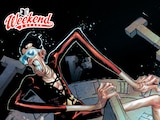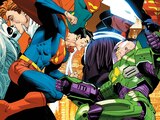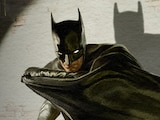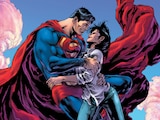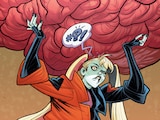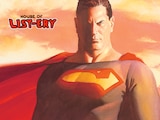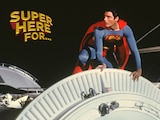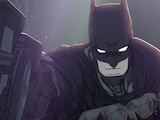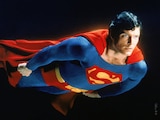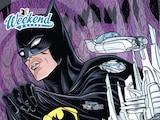Happy New Year, and welcome to another edition of ASK…THE QUESTION! I’m Alex Jaffe, better known to our friends in the DC Community as HubCityQuestion—the DC Universe expert who knows just about everything you ever wanted to know about DC and all it entails. And what I don’t know, well, I promise to do my very best to find out. As long as you keep asking, I’ll stick around to answer. Let’s take a look at some of our latest solved cases!
Through the Looking Glass

idle453.87595 asks:
Have the Mad Hatter and Cheshire ever met? And what about the White Rabbit (the Batman villain)?
Mad Hatter encountered Cheshire for the first time in Gail Simone’s 2006 Secret Six miniseries, when he’s poisoned by her in the third issue.
Interestingly, White Rabbit appears as a member of Mad Hatter’s Wonderland Gang on the cover of 2012’s Batman: The Dark Knight #8, but doesn’t actually feature in the gang at any point in the story, suggesting there was an editorial change or perhaps a mistake on the artist’s part (as, coincidentally, White Rabbit had been the featured villain in the series’ previous arc). Both are active participants in Forever Evil: Arkham War, but they do not interact directly.
To date, White Rabbit and Cheshire have never crossed paths. But seeing as Ms. Jaina Hudson has been an active player of late in the ongoing Batman and Robin, I’d keep your eyes on that title for potential further developments. (Granted, please consult the end-of-article disclaimer regarding my own lack of foreknowledge regarding unpublished issues.)
Statue of Limitations

RexRebel asks:
I remember reading somewhere awhile back that when DC first started making or licensing statues that Death from Vertigo was the first one. Is that correct or is there some other statute from the dawn of time out there?
DC’s collectibles division came about during The Sandman’s heyday, so that’s not implausible. The first statue of Death, sculpted and released by Randy Bowen in 1993, is indeed one of DC’s first statues altogether.
But Death is predated by a few earlier statues. The first statue licensed from DC was actually of her younger brother, Dream of the Endless as the titular Sandman himself, in 1991—also sculpted by Bowen.
Between Dream and Death, DC would release statues of Batman and Lobo in 1992. The first Superman came the same year as Death, followed by Robin and another version of Dream in 1994, and the first Wonder Woman, Joker and Flash statues in 1995.
Reborn Recap

Corpsmember.78 asks:
I am rereading DC Rebirth’s Justice League: The Extinction Machines. In the first few pages, Lois and Clark are discussing if he should return as Superman for their new world, in which that world’s Superman has died. My question is: wtf is going on? The story gives zero context as to how this Kent family got to this new Earth, what Earth it’s taking place on or how the old Superman died. Is this Kent family the same that’s in canon in DC now?
This was a pretty complicated time in Superman’s history, which was later streamlined in the Rebirth Superman and Action Comics crossover “Superman Reborn.” At the time “The Extinction Machines” was published, the Superman of the New 52 had been killed in the “Final Days of Superman” story that ran through the last issues of the New 52 Action Comics and Superman.
Meanwhile, as shown in the Convergence event, and subsequently the Superman: Lois and Clark miniseries by Dan Jurgens, the Pre-Flashpoint Superman had actually landed on the New 52 Earth with Lois and Jon Kent ten years prior to the modern day, raising their kid together in secret.
After the New 52 Superman died in a battle with Denny Swan, the Energy Superman, in “Final Days of Superman,” the Pre-Flashpoint Superman emerged from hiding to take his place. That Superman is the one you’re reading in this early Rebirth story.
This was all much too complicated for most readers to follow, so Mxyzptlk would help alter reality to consolidate both Supermen into a single entity in “Superman Reborn.” Where there were once two Supermen, there was now only one once more.
The Devil in the Details

AnuTheWorm asks:
In J.M. DeMatteis’ Spectre run, there are a few appearances by a female demon addressed as simply “Satan” or “The Devil.” Some fans consider her an incarnation of the First of the Fallen, but is that actually true? And are there any other appearances by “Devil” characters who are not readily identifiable with the First and/or Lucifer? I’d imagine the Golden and Silver Ages must have some?
The nature of the devil in the DC Universe is pretty inconsistent across different titles. I’d say the supposition that she’s specifically meant to be the First of the Fallen is an assumption on the fandom’s part. (Notably, the First of the Fallen is a character who only exists to account for two different titles needing to use the figure of Lucifer at once.) Rather, think of the devil in these stories less as a concrete character with consistent history and attributes across titles and more like a different writer’s interpretation of what the collective cultural idea of a “devil” can represent. After all, the manifestation of ideas in physical form is a major theme in DeMatteis’ Spectre.
As for others, a few who come to mind immediately is the primordial demon “Shathan” in John Ostrander’s own Spectre run, Elliott S. Maggin’s “CW Saturn,” meant as his Satan analog in his Miracle Monday Superman novel and, of course, Trigon, who was envisioned by Marv Wolfman and George Pérez as an extradimensional entity who inspired our idea of the devil to begin with.
Naturally, the devil has many other appearances in older comics as well, drawing on our cultural ideas of Satan as opposed to any kind of consistent canonical figure. (Finally, I would be remiss not to mention that time Lois Lane almost married Satan, but it was really just an alien who looked like Satan.)
Before we sign off, I thought I’d kick off 2024 with an exclusive treat for you. Over the years that I’ve run ASK…THE QUESTION, there’s one question about my favorite hero that I’ve gotten more often than any other.
Answering the Question

TheBatgirlofNoMan’sLand, masterchief7390 and many others have asked:
Was the identity of the New 52’s Question ever revealed?
In 2012, Geoff Johns introduced the concept of the “Trinity of Sin” into his ongoing Justice League narrative: a trio of mystic felons with crimes so heinous that they would be forced to bear their consequences for eternity. These three entities were Phantom Stranger, Pandora…and a new version of the Question, his true face and identity erased from history. While the Trinity of Sin: Pandora and Phantom Stranger comic series explored the history of the first two members of this Trinity, readers never learned the Question’s story—a fact this Question himself laments during his final appearance in Trinity of Sin #6.

For twelve years, as the internet’s resident Question expert, I’ve been asked this question numerous times, and have had to tell all who wished to know the same: I know as much as you do on this one. This has never sat well with me. So I resolved, for the sake of my readers and my own peace of mind, to get some kind of resolution to this unwritten story.
Near the end of 2023, I managed to secure some time for an interview with Geoff Johns himself during New York Comic Con. The question on the forefront of my mind was this piece of trivia which had long eluded us fans of the faceless detective. Geoff told me he couldn’t quite remember what his plans were—to be fair, between Justice League, Green Lantern and Aquaman, he was dealing with a lot at the time—but he’d consult his notes and report back.
Two weeks later, Geoff Johns proved good on his word, as he sent me this email:
The Trinity of Sin was Pandora, the Phantom Stranger and the Question. Reimagined as a mystical character, [the Question’s] identity was going to be, like Pandora and Stranger, tied to a sinner of the ancient world—Narcissus, who stared at his own face out of pride, etc. so it was wiped away—cursed to walk without a face.

Ultimately, we were going to explore them all in the Trinity War story—where we would have revealed who cursed them in the first place (a new angel character). The Spectre was going to be a big factor in the story and take center stage. It was all going to be about sins and can you be redeemed—an exploration of redemption. We’d explore it with villains in the DCU, which would have led to Forever Evil and the villains having to become the saviors of the world.
Ultimately, editorial wanted to expand on Pandora and Phantom Stranger into their own series and had other ideas to explore the Trinity of Sin. So at that time, those books took over that storyline and we skipped it and went straight to the evil place that Pandora’s Box was a portal to: Earth-3 and the Crime Syndicate, and then Forever Evil. The other writers of the other books would know more than me what the Trinity of Sin evolved into.
If I had a thousand years to guess, I never would have arrived at that myself. My thanks to Geoff for coming through on this long-lost story. Hopefully, more enlightenment awaits us all over this new year. It all begins when you ASK…THE QUESTION.
Alex Jaffe is the author of our monthly "Ask the Question" column and writes about TV, movies, comics and superhero history for DC.com. Follow him on Bluesky at @AlexJaffe and find him in the DC Community as HubCityQuestion.
NOTE: The views and opinions expressed in this feature are solely those of Alex Jaffe and do not necessarily reflect those of DC or Warner Bros. Discovery, nor should they be read as confirmation or denial of future DC plans.

